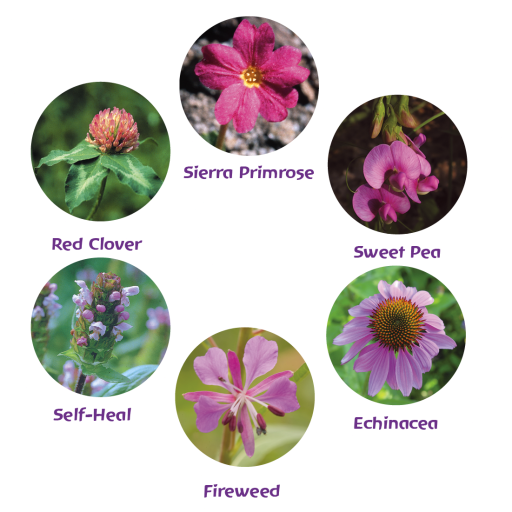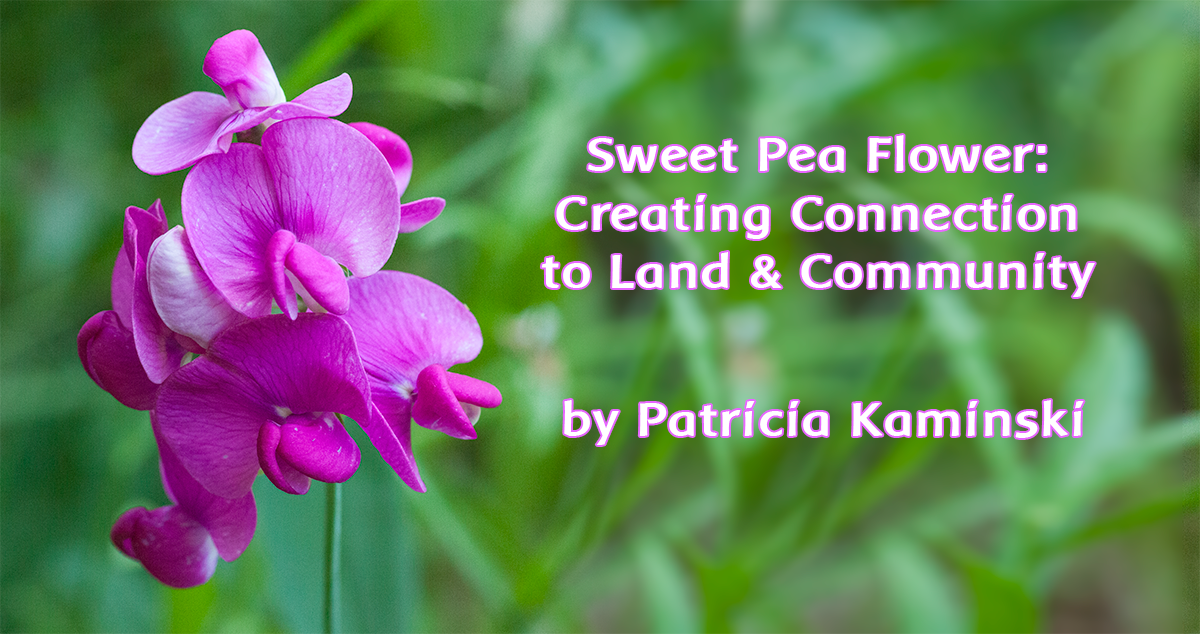
Sweet Pea Flower: Creating Connection to Land & Community
by Patricia Kaminski
In early summer the Sweet Pea flower graces the Sierra foothills with her bright magenta blossoms. Her entwining embrace is a gentle kind of encircling of the periphery. Sweet Pea flourishes best in the outskirts of domestic areas – in the liminal spaces between human and wild habitats. By contrast, one does not find her growing in truly wild parts of Nature, remote from human habitation. The tender tendrils of her “fingers” mostly prefer to weave their graces just where the human and the elemental world intersect. Significantly, this “wild” Sweet Pea plant is one that originally naturalized from a domestic variety, gradually adapting her being to the interface of domestic and primal forces.
The Legume Botanical Family: The Nourishing and Fertilizing Forces of Air Meeting Earth
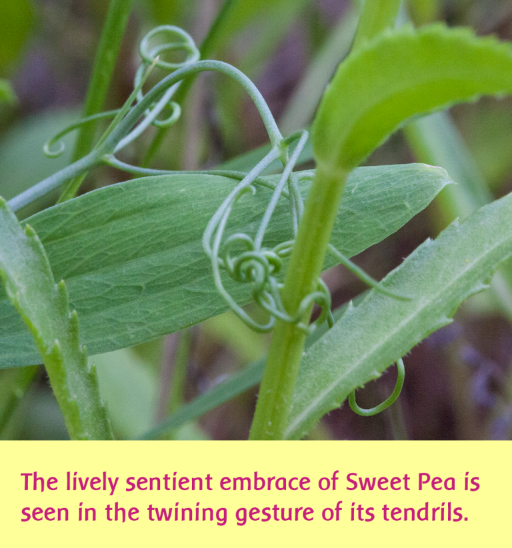 Sweet Pea, Lathyrus latifolius* (see further note at the end of this article) is an intriguing member of the Legume or Fabaceae botanical family. This group of plants have a remarkable capacity to “ensoul” the air or astral forces surrounding the earth so that they become nourishing, fertilizing forces in the ground of the earth. For example, in the folk wisdom of traditional agriculture, the soil was always replenished with “cover crops” of legumes such as clovers. These regenerative plants guided the element of nitrogen – one of the major fertilizing components found in the upper atmosphere – to enrich and fertilize the soil. This beneficial practice is a far cry from the harsh chemical forms of synthetic nitrogen and related chemicals that are pummeled into the earth in industrial agriculture without the intermediary benefits of the living, etheric activity of legumes. Thus, chemical forms of nitrogen are ultimately destructive and depleting to the soil rather than up-building.
Sweet Pea, Lathyrus latifolius* (see further note at the end of this article) is an intriguing member of the Legume or Fabaceae botanical family. This group of plants have a remarkable capacity to “ensoul” the air or astral forces surrounding the earth so that they become nourishing, fertilizing forces in the ground of the earth. For example, in the folk wisdom of traditional agriculture, the soil was always replenished with “cover crops” of legumes such as clovers. These regenerative plants guided the element of nitrogen – one of the major fertilizing components found in the upper atmosphere – to enrich and fertilize the soil. This beneficial practice is a far cry from the harsh chemical forms of synthetic nitrogen and related chemicals that are pummeled into the earth in industrial agriculture without the intermediary benefits of the living, etheric activity of legumes. Thus, chemical forms of nitrogen are ultimately destructive and depleting to the soil rather than up-building.
In the Sweet Pea plant we can see a marvelous reflection of many of the qualities of the Legumes. Her roots are so firmly grounded that they will come back each year, no matter whether cut back or trampled upon. She increases her presence by the spreading activity of her vines, her searching tendrils gradually covering the earth and establishing new rootlets. One perceives a remarkable sensitivity in her leaves that gently open and close with the light, a sentient quality that is even more pronounced in some of her relatives like the Mimosa pudica, whose leaves immediately fold inward when touched.
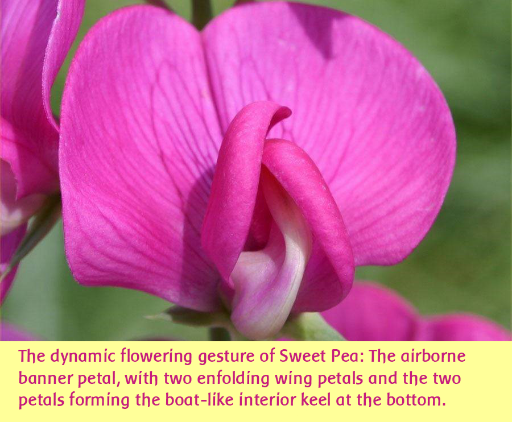
The flower of the Sweet Pea is dynamically structured, with five sepals fused together, and five petals. The uppermost “banner” petal is the largest of the five. The enfolding petals adjacent to the banner on either side are called the “wings,” while the lower two petals are fused at their tips, forming an interior structure resembling a boat, and therefore called the “keel.” When one ponders this flower with imaginative contemplation, we come to its essential gesture.
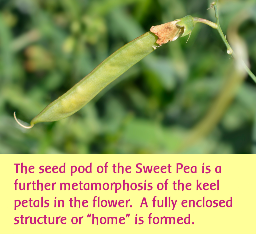 The Sweet Pea flower reaches up with its banner flower into the atmosphere, with its airborne wings enfolding this astral substance and directing it into the interior formation of the keel. This gesture of ensouling the air-astral substance, to make an inner space, is then marvelously displayed in a further metamorphosis into the seed pod. This pod is the fully enclosed structure or “home” for the precious substance of its seed until it is ready to be released into its larger home on earth.
The Sweet Pea flower reaches up with its banner flower into the atmosphere, with its airborne wings enfolding this astral substance and directing it into the interior formation of the keel. This gesture of ensouling the air-astral substance, to make an inner space, is then marvelously displayed in a further metamorphosis into the seed pod. This pod is the fully enclosed structure or “home” for the precious substance of its seed until it is ready to be released into its larger home on earth.
Sweet Pea Flower Essence:
Finding One’s Place on Earth and Anchoring Community Consciousness
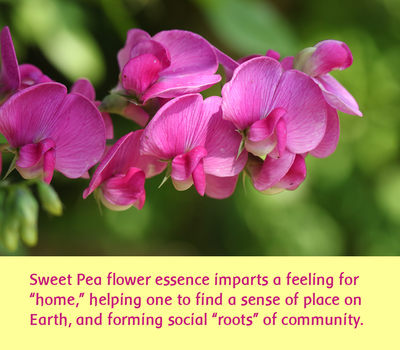 As we live with a deeper appreciation for how Sweet Pea grows and forms itself, we can come to more clearly understand the qualities she bestows as a flower essence. This flower imparts a feeling for “home,” by establishing a sense of place on Earth, and forming social “roots” of community. Ultimately this containing and grounding activity allows our higher soul impulses to find a genuine way of serving, of nourishing others and replenishing the social fabric of Earth and Community.
As we live with a deeper appreciation for how Sweet Pea grows and forms itself, we can come to more clearly understand the qualities she bestows as a flower essence. This flower imparts a feeling for “home,” by establishing a sense of place on Earth, and forming social “roots” of community. Ultimately this containing and grounding activity allows our higher soul impulses to find a genuine way of serving, of nourishing others and replenishing the social fabric of Earth and Community.
The one who needs the Sweet Pea flower is typically influenced by the archetype of the Wanderer or the Seeker; wanting to be free to explore or discover wider realms, not wanting to “put down roots.” This can be a positive impulse at certain stages in life, especially in one’s youth, but it can also be detrimental when it robs the soul of a deeper social and landed identity. In our modern world this ever-shifting unsettled quality of body and soul is especially pronounced. Many have experienced growing up in families that involved constant re-location, or in urban, technological environments with continual traffic and other incessant forms of movement, that allowed scant connection to community or the earth. Even deeper impact involves those who have been completely uprooted from their places of origin due to migration, war, natural disaster or other forms of traumatic dislocation.
Case Example: Overcoming Childhood Social Trauma and Finding Nourishing Connections to Others
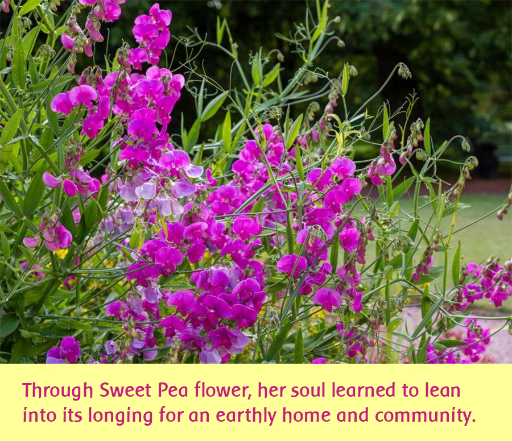 A woman in her mid-thirties used this remedy as a single essence for several months at the recommendation of her therapist. She was in the throes of another of many failed relationships, making plans to move in order to “get away” from her trauma and sense of dissatisfaction. She described growing up in a military family that frequently moved about and how she was never able to form any lasting bonds with friends in school. As a girl she resented the constant moves of her family; yet as a free adult she was unconsciously replicating these same patterns.
A woman in her mid-thirties used this remedy as a single essence for several months at the recommendation of her therapist. She was in the throes of another of many failed relationships, making plans to move in order to “get away” from her trauma and sense of dissatisfaction. She described growing up in a military family that frequently moved about and how she was never able to form any lasting bonds with friends in school. As a girl she resented the constant moves of her family; yet as a free adult she was unconsciously replicating these same patterns.
As this woman used the Sweet Pea flower essence, she began to remember the reason she had originally moved to the geographical region in which she now resided. She cherished the trees, the lakes, the flora and fauna of this place on earth that made her feel so inspired and invigorated. She realized she could affirm her heart’s connection to the land that surrounded her, even if she felt unloved by her partner. These resurgent feelings led her to new volunteer activities within her community, and eventually new opportunities in her professional work. These connections in turn led to meeting her true partner in life. Several years later, she recalled how the Sweet Pea flower essence had facilitated a pivotal turning point in her life. She was able to break the pattern of “running away” and disconnecting from earth and community when she felt challenged or dissatisfied. Instead, her soul had learned to lean into its longing for an earthly home and community, in turn leading to a relationship that flourished through these very values.
Sweet Pea: Instilling A Sense of Home and Social Bonding for Displaced Animals
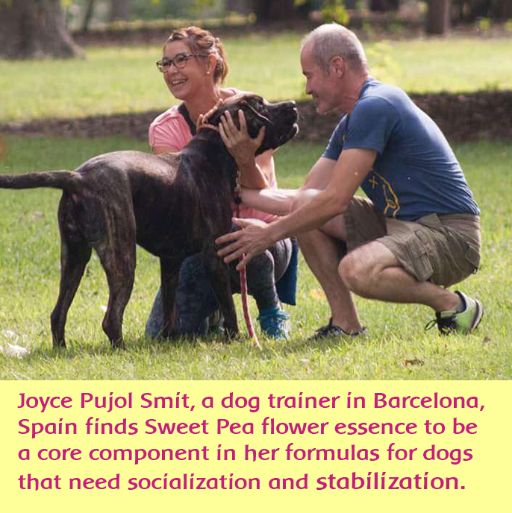
Joyce Pujol Smit, a master flower essence therapist and dog trainer in Barcelona, Spain, reports on the central role of Sweet Pea in helping displaced, adopted or shelter dogs find a new sense of belonging and secure territory. See her extensive report here, featuring Sweet Pea flower essence in several cases to facilitate openness to a new environment, especially the ability to feel safe and at “home.”
Sweet Pea is often used along with Quaking Grass to help newly adopted animals develop social bonds with other animals, as well as with their human caretakers. For example, a practitioner reported the successful use of these two remedies for an adopted cat from a shelter, who cowered underneath furniture or else hissed at the other cat in her new home. Gradually, with these flowers, the adopted cat learned to trust her new home and was able to receive and give affection to her new caretaker.
Magenta Mantle – A Formula for Healing the Land, Featuring Sweet Pea Flower Essence
In addition to its other qualities, a significant feature of the Sweet Pea is the magenta color of its flower. This color imparts a quality of etheric vitality, renewal and regeneration. Sweet Pea flower essence is an important component of a formula called Magenta Mantle, featuring six magenta colored flowers (Sweet Pea, Red Clover, Fireweed, Self-Heal, Echinacea and Sierra Primrose). This concentrated formula is diluted in water and sprayed directly onto the land and surrounding air following any devastation, disruption or other destructive force. For instance, it has been used extensively in Japan in the aftermath of the Fukushima nuclear disaster. The Magenta Mantle helps regenerate the etheric vitality of the land and builds new foundations of belonging and connection for those who have lost their homes or communities.
Distinguishing Sweet Pea from Similar Flower Essences
Wild Oat
Both Sweet Pea and Wild Oat help to heal restless and aimless states of over-activity and lack of commitment. In the case of Wild Oat the need of the soul is to find true connection and purpose in life. The Wild Oat type is chronically dissatisfied and restless because there is not a true inner sense of one’s vocation or social purpose. Healing for the Wild Oat personality involves being able to hear one’s Higher Destiny Voice (vocare or vocation) and thus one’s place in the social fabric of life. In the case of Sweet Pea the need is more specifically one of grounding by being able to feel nourished by and connected to one’s environment and community.
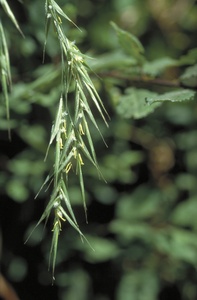

California Poppy
Sweet Pea and California Poppy both address the archetype of the seeker or wanderer. However, in the case of the California Poppy the restless, changeable condition of soul is driven by attraction to what seems more glamorous, glittering or exalted. The California Poppy state of consciousness is often fueled by excarnating drugs or spiritual practices that remove one from solid grounding in the body, and practical qualities of judgement and discernment. This results in constantly shifting, superficial desires for happiness or bliss that are only temporarily fulfilled. On the other hand, the Sweet Pea type is unable to anchor a sense of place or home, or to develop positive social roots in community and relationships.
Quaking Grass
Sweet Pea and Quaking Grass are often used together, since both essences facilitate healthy bonding and social connection. The specific role of Quaking Grass is to assist overly-individuated, egoic states of consciousness by building more sensitive awareness of the needs and psychic realities of others in social situations. The Sweet Pea helps to build the social bonds that anchor, nourish and positively connect one to the surrounding social and physical environment.
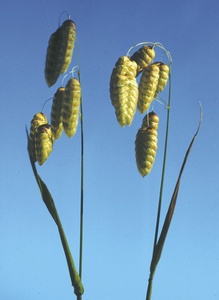
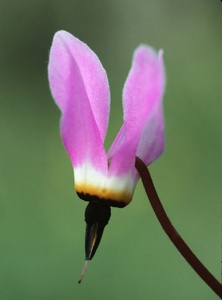
Shooting Star
Both Sweet Pea and Shooting Star share qualities of social alienation and disaffection. In the case of Shooting Star, the cause lies more deeply within the incarnational journey of the soul into the body. This often involves hesitation of the soul as it approaches incarnation, or actual birth trauma. Because it has not fully transitioned from its cosmic identity, the Shooting Star type feels not quite human on earth, unable to feel fully connected to human love and bonds of community. By contrast, Sweet Pea helps one find nourishment and connection in life through anchoring to the elemental forces of the land and the surrounding social community. In certain cases, both of these flowers are used in tandem with beneficial results.
Spreading Phlox
Both Spreading Phlox and Sweet Pea encourage reaching out to establish new social connections. In the case of Spreading Phlox, one is addressing a stagnation in social consciousness, often due to the encrustation of old bonds such as birth family ties that are no longer productive for the potential and destiny of the individual. Instead there is a need for new outreach, adventure and exploration in social realms. On the other hand Sweet Pea helps establish social connectivity when the inner sense for one’s place on earth, community and true home is deficient or traumatized.
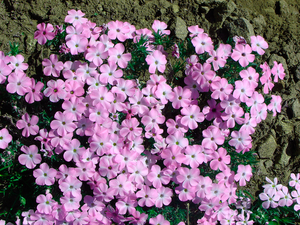
*Botanical Note: Lathyrus latifolius, also known as the Everlasting Pea, should not be confused with the popular garden Sweet Pea, Lathyrus odoratus. Lathyrus latifolius is a naturalized perennial species of Sweet Pea, which has adapted itself to thrive in the elemental periphery as described above and therefore has the healing characteristics described in the flower essence. In addition to habitat and growing differences, the Lathyrus latifolius is not fragrant. Instead the astrality typically found in the fragrance of the Sweet Pea has metamorphosed into an ensouling gesture united with etheric weaving forces in the elemental world.

To install this Web App in your iPhone/iPad press ![]() and then Add to Home Screen.
and then Add to Home Screen.

